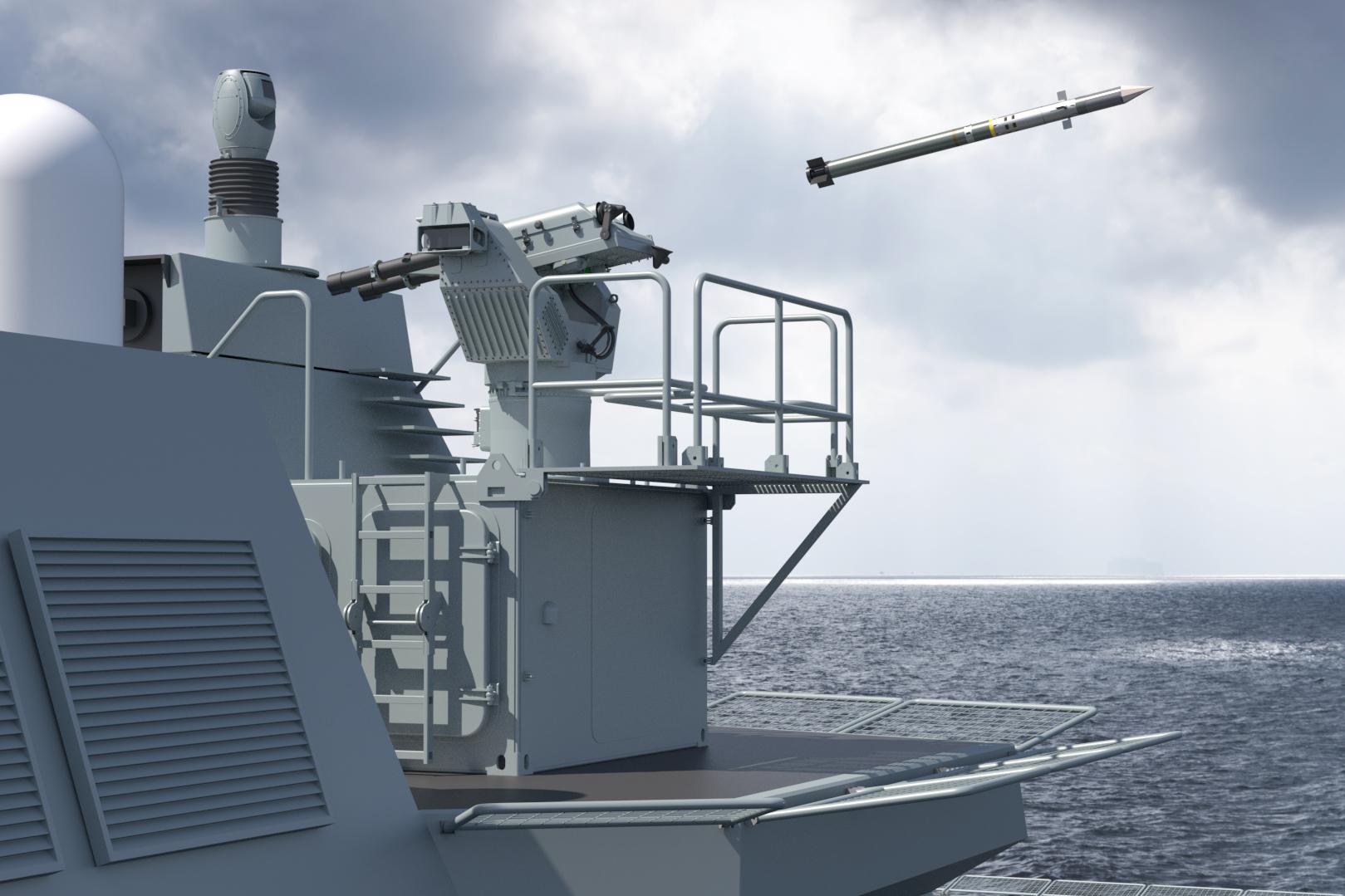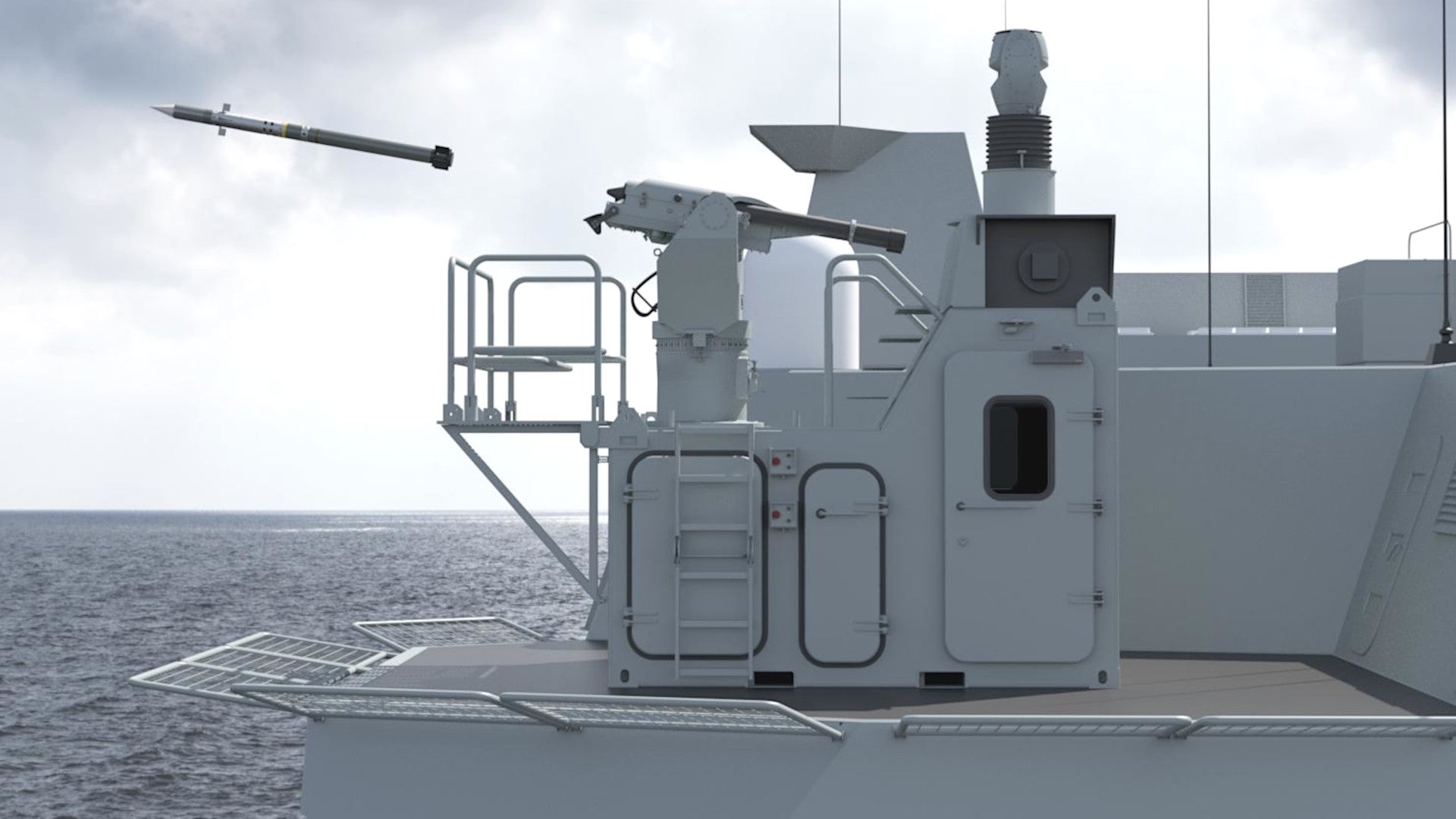European missile consortium MBDA is now offering a containerized short-range air defense system utilizing the Mistral heat-seeking missile. The multi-national company is pitching the system as ideal for use on support ships, such as naval supply vessels that do not have their own fixed defenses, but it could have other roles, including on land.
On Feb. 17, 2019, MBDA unveiled what it calls the Self-Protection Integrated Mistral Module (SPIMM) at the Navdex exposition in the United Arab Emirates. The company derived the system from their existing SIMBAD-RC naval mount for the Mistral missile, which has been in production since 2014.
“The SPIMM enables the urgent and rapid adaptation of supply vessels or landing platform docks to cope with new threats, or for using them in contested areas,” Christophe Leduc MBDA’s Naval Defense Systems Product Executive, said in a statement on Feb. 17, 2019. “This system illustrates MBDA’s ability to understand its customers’ needs and to quickly come up with effective and functional solutions.”
SPIMM consists of the same turret as the SIMBAD-RC, which has two ready-to-launch missiles, on top of a two-man control station. The container also has storage space for four additional missiles.

A 360-degree panoramic infrared camera system detects targets and cues the missiles. Each Mistral, which has a maximum range of close to four miles, then uses its own imaging infrared seeker to home in on the target. This guidance system means the weapon can hit threats with relatively limited thermal signatures and has added resistance to being duped by decoy flares and other countermeasures.
In the maritime role, Mistral has the ability to engage low-flying combat aircraft, helicopters, and small unmanned aerial vehicles, as well as act as a point-defense system against incoming anti-ship missiles. In January 2019, the company announced it had successfully tested the weapon against surrogate small surface targets, representing threats such as fast attack craft and suicide boats.

Unlike with SIMBAD-RC, SPIMM does not require a ship to have anything besides space to accommodate the container and an electric connection linking it to the vessel’s own power supply. Built to conform the general dimensions of an ISO-standard shipping container, existing cranes and forklifts can readily move and reposition the seven-ton, 10-foot long system.
The entire system offers an immensely flexible self-protection system for ships that don’t already have close-in defenses. Though SPIMM wouldn’t be capable of tackling high threat environments by itself, it could add an extra layer of protection on otherwise unarmed support ships operating in those area together with surface combatant escorts.
Shore-based anti-ship missiles are increasingly proliferating, even among non-state actors, which only increases the value of being able to rapidly install the SPIMM on supply vessels with with limited defenses. There is also an increasing need to be prepared to defend against swarms of manned and unmanned small surface craft, including boats laden with explosives, even in relatively low-risk environments. There is a similarly growing risk of mass drone attacks or hostile drone swarms, as well.
Various countries, including the United States, have already taken to positioning ground-based short-range air defense systems, including “soft-kill” electronic warfare systems, on the decks of amphibious ships to provide this kind of capability when necessary. SPIMM offers a more robust “hard-kill” punch, something more capable than an individual with a shoulder-fired surface-to-air missile for instance, to go along with soft-kill systems. The containerized system would also offer this sort of protection to vessels without embarked ground forces or ships that had just delivered those units to their destination.
The video below shows Egyptian Avenger short-range surface-to-air missile systems on the deck of one of the country’s Mistral-class amphibious assault ships.

SPIMM isn’t the first containerized air defense system concept, either. After the Falklands conflict in 1982, the United Kingdom considered a concept for turning container ships into impromptu aircraft carriers, known as the Ship Borne Containerized Air Defense System (SCADS). This proposal, which didn’t come to fruition, involved a containerized Seawolf surface-to-air missile system.
The U.K. Ministry of Defense recently announced plans to acquire new Future Littoral Strike Ships (FLSS), a concept that also appears to use militarized commercial vessels. The Royal Navy might again containerized air defense system, such as SPIMM, as a way of rapidly adding close-in self-defense capability to those ships. The containerized system could be ideal close-in defense add-on for ships configured
as sea bases, as well as unpowered barges and offshore platforms.
The containerized system might also present a cost-effective alternative to more purpose-built fixed air defense systems on ships, in general. A country’s navy would not necessarily have to purchase SPIMMs for every ship in need of these defenses, instead swapping them between vessels in between deployments.
The SPIMM’s flexibility also means that MBDA may soon be looking to offer it in the land-based role. The European consortium already offers a number of different vehicle-mounted Mistral options with manned and remote-control turrets. Mistral’s most basic launch option is a man-portable, shoulder-fired system.

But the container-based version, which would need an external power source, could be attractive to countries interested in rapidly setting up fixed point air defenses at established bases or more austere forward operating locations. Any truck capable of carrying ISO-standard containers would be able to reposition them as necessary, too. It is possible that a future SPIMM variant with self-contained power source could completely negate the need for a dedicated host vehicle.
There has been a growing trend toward the development of containerized weapon systems of various types in recent years, in general, due to the flexibility this type of packaging offers. There are already examples of containerized remote-controlled sentry systems, turreted mortars, anti-ship cruise missiles, and even short-range ballistic missiles.

We at The War Zone were first to report in October 2018 that Northrop Grumman had revealed a concept for a containerized ground-based anti-radiation missile launcher to destroy enemy air defenses, as well as other targets. This system will be able to use either the company’s AGM-88E Advanced Anti-Radiation Guided Missile (AARGM) or the up-coming Advanced Anti-Radiation Guided Missile-Extended Range (AARGM-ER).
SPIMM’s appearance on the market only adds to this vast array of containerized weapon options. The system’s ability to engage a variety of air, missile, and surface targets only adds to its flexibility and could definitely make it very appealing in a variety of roles at sea and on land.
Contact the author: jtrevithickpr@gmail.com
